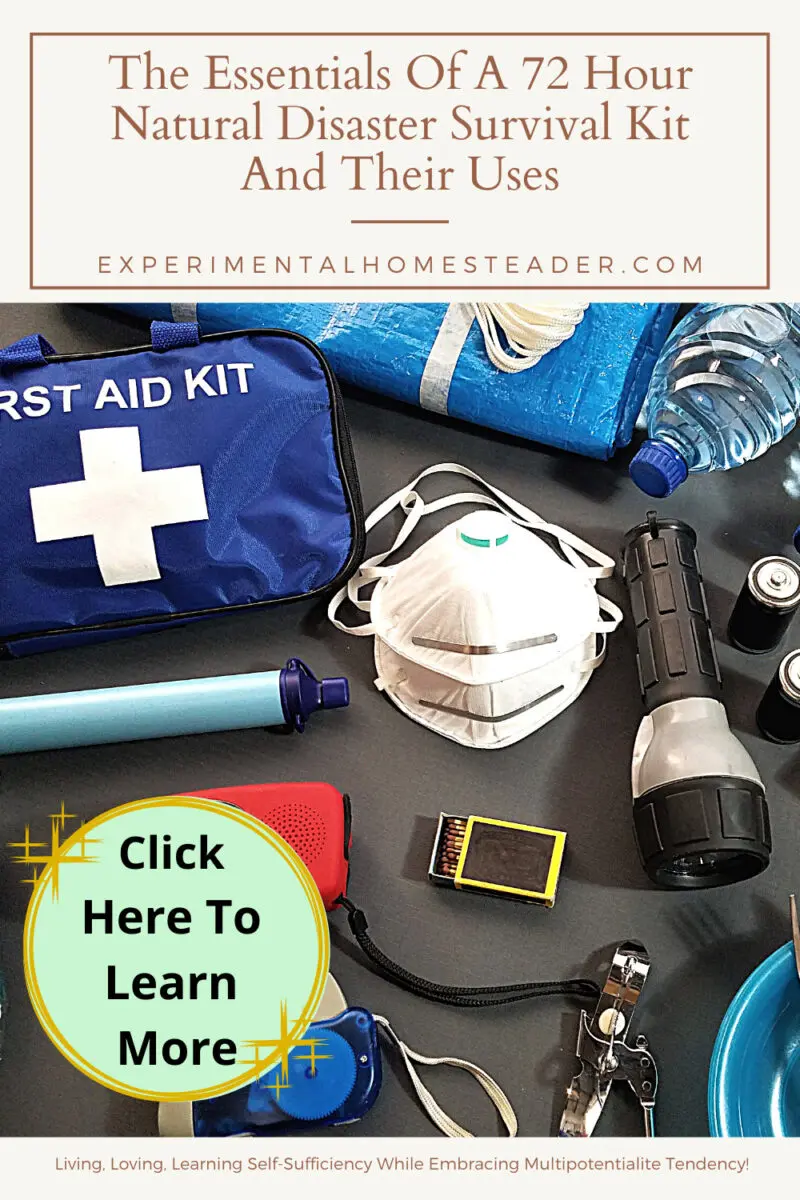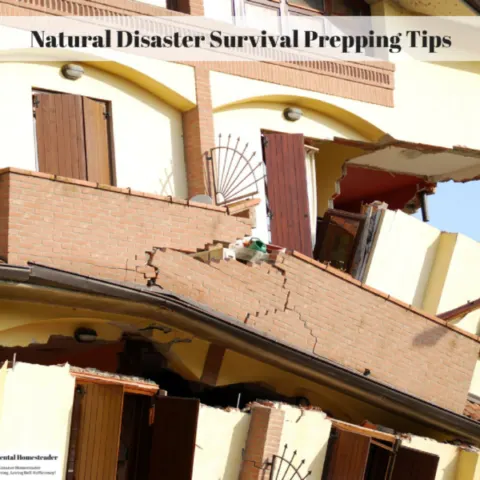There are some things you want in a natural disaster survival kit for necessity and some you want for comfort.
Some of these things work well in bug out bags and others do not because of their size or weight.
When you plan your 72 hour natural disaster survival kit, I encourage you to make two separate kits - one for bugging in and one for your bug out bag that includes light weight items instead of the bulkier ones you would use at home.
What Is A Bug Out Bag Natural Disaster Survival Kit?
A bug-out bag is a natural disaster survival kit that contains enough supplies to help you survive through a natural disaster or man-made catastrophe for a period of seventy-two hours.
Without a bug-out bag, you may have to face the full impact of the disaster in question while experiencing hunger or discomfort.
The supplies contained in a bug-out bag might vary slightly depending on your geographical region, there are some essential supplies that are absolutely necessary for a bug-out bag to qualify as complete.
This is why it is so important to understand how to create your own short-term emergency preparedness disaster survival kit.
Understanding is just the first step though, you must also act on that knowledge and create a 72 hour emergency survival kit.
Below are some of the essentials to include in your 72 hour natural disaster survival kit.
Water Is A Must Have For A 72 Hour Natural Disaster Survival Kit
Water is one of the basic essentials you need to survive in both emergency and non-emergency situations.
Our body requires a certain amount of water on a daily basis in order to function properly.
It is important to have at least three liters of water per person to survive seventy-two hours.
Our bodies must receive a bare minimum of least one liter of water every day in order to sustain our health.
It is wise to stock up on more water if you have the room, because you do not know how much you might go through or who you might end up sharing your stash with.
It is also important to note that a basic water purification system, comprising of a water filter or water purification tablets, can help you survive through a disaster for more than seventy-two hours.
Instead of trying to pack bottles of water, which can get heavy quickly, it is wise to stock your bug-out bag with an item that has the ability to refine and purify water such as water purification tablets or a water purification filter.
Collapsible water bottles take up less space and are better to put into your evacuation bag instead of a standard water bottle.
Food Is Essential Part Of A 72 Hour Natural Disaster Survival Kit
If you are stranded for seventy-two hours without any food, you are going to get very hungry and maybe even end up sick.
Hence, while preparing your bug-out bag, the importance of including food must be considered.
Food items that you decide to put in your bug-out bag must be rich in energy, light weight and easy-to-prepare.
Prepackaged Meals Ready to Eat (MRE's) are ideal because they contain everything you need in one small pouch plus they are light weight and do not take up a lot of room.
For a 72 hour natural disaster survival kit, you need nine meals per person if you intend to eat three meals a day.
Each person should carry their own food in their own evacuation bag.
In the event you are bugging in, simply making sure you have enough food to sustain you and your family, as well as a way to cook the food, is essential.
Include Clothes In Your 72 Hour Natural Disaster Survival Kit
Clothing items such as a pair of boots, long pants, a couple pair of socks, a spare shirt and a rain-jacket or poncho are important essentials that your bug-out bag really should contain.
You may have to tackle certain unexpected situations, such as a torrential downpour or relentless snowing, for which adequate clothes are necessary.
Therefore, it is always great to be well-prepared in order to avoid inconvenience.
To help limit the weight of the bug out bag, wearing the boots is an option, but be sure they are well broken in because the last thing you want to do in an emergency situation is wear new boots or shoes that hurt your feet.
One way to save room in your evacuation bag is to vacuum seal the clothing to compress it, but be sure you have either a knife or scissors so you can get the bag open quickly when you need the clothing.
This is also an item that each person should carry in their own bug out bag simply because you don't know if you might end up separated while trying to get to safety.
Warm, dry clothes are essential to help prevent sickness.
Bedding Is Also Part Of A 72 Hour Natural Disaster Survival Kit
In order to spend three days on your own trying to survive a natural disaster or man-made catastrophe, you need a dry, warm place to sleep.
Your bug-out bag must contain a tarp or a tent, a ground tarp to put under the place you sleep and a good and a comfortable sleeping bag.
The importance of shelter cannot be reiterated enough as it is one of the most basic, yet often overlooked, requirements for survival because it keeps you out of the weather.
To save room in your evacuation bag, you could either vacuum seal the sleeping bag, however, depending on the size of the sleeping bag, the vacuum sealed bag could get heavy.
For those bugging in, I advise keeping an extra sealed container filled with blankets and sleeping bags just in case you need them.
Placing some dryer sheets in between the blankets will help keep them from smelling musty.
Include A First-Aid Kit In Your 72 Hour Natural Disaster Survival Kit
The importance of a first-aid kit to a bug-out bag is self-explanatory.
A first-aid kit is likely to come in handy in case of unforeseen emergencies at the time of a disaster.
You can either set up your own first-aid kit or purchase one to avoid the hassle.
It is important to have one for adults and another first aid kit for children.
Periodically check the first aid kit and rotate out any items that are about to expire.
If you cannot use them up yourself - for example Children's Tylenol, if you do not have children, give them to someone who can.
Final Thoughts On A 72 Hour Natural Disaster Survival Kit
These are only some of the numerous things that your bug-out bag should contain.
Putting weapons, flashlights and devices for communication in everyone's bug out bag is a great idea.
Take the time to make sure everyone knows how to use the communication equipment before they are actually needed and that the batteries in the equipment are fully charged.
It is also a good idea to pack some extra batteries or a solar charger for the communication equipment.
Also, if you or anyone in your house is on medication, it is important to keep a supply of medications on hand that would last for seventy-two hours or more.
It is also important that you pay attention to the expiration dates and rotate the medication in your bag so if you need it is not outdated.
Natural Disaster Emergency Readiness Tips
How To Create Your Own Short-Term Emergency Preparedness Disaster Survival Kit
An important part of survival prepping is being ready for any situation - long or short-term. Start prepping today by creating your own short-term emergency disaster survival kit!
Natural Disaster Survival Emergency Plan
Do you have a natural disaster survival plan in place? If not, here are some great survival tips for disasters that you can use to formulate your plan.
How To Prepare For Disaster Survival
Now is the time to learn how to prepare for disaster survival! Disaster prepping helps with everything from nuclear threats to natural disaster survival.
Natural Disaster Survival Prepping Tips
Natural disasters happen everywhere, sometimes with no advance notice. Check out these survival prepping tips and start prepping for survival now!
Urban Survival Essentials For Beginners
When SHTF, living in the city has its own set of challenges. Find what urban survival essentials for beginners you need to learn and store.
Top 10 Survival Tips For Disasters
Being prepared for disaster survival is essential. Check out these ten survival tips for disasters and start preparing today!
Tips For Shopping Online For Survival Gear
If you're thinking of buying supplies for an emergency situation or natural disaster, be sure to check out these tips for shopping online for survival gear.














